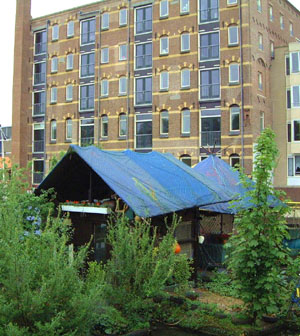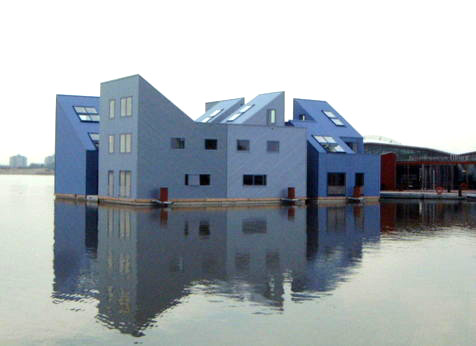A home that rises with the water

After hurricane Katrina, Susan Taylor Martin, senior correspondent of the Saint Petersburg Times, traveled to the Netherlands. Approximately half of this country is below sea level and parts have been struck by floods. Maybe the Dutch have something interesting to tell… So Susan spoke with several Dutchmen…
A home that rises with the water
Fears of floods have made the Dutch see a future of floating cities.
In the meantime, they’re doing it one house at a time.
By SUSAN TAYLOR MARTIN
Times Senior Correspondent Published November 7, 2005
MAASBOMMEL, Netherlands – Like most Dutch, Jos Verheijen thinks there’s nothing finer than a solid brick house. The fact he’s in the brick business makes him even more partial.
Yet when he invested in a vacation home near the Maas River, he got a house made of wood. The reason? It floats.
In a nation with a history of disastrous floods, Verheijen is in the fore of a slow but intriguing trend toward houses that adapt to changes in water level. His two-story, 2,000-square-foot place looks like a regular house, but can float upward as much as 18 feet.
It’s an innovative solution to a worldwide problem, most recently dramatized by the catastrophic flooding that left thousands homeless in New Orleans after Hurricane Katrina. And at a time of great concern over climate change and rising sea levels, Dutch visionaries foresee a day when entire cities might float on the world’s oceans.
“The number of people living on this planet is 6-billion now, and it will be 9-billion in 2050,” says Frits Schoute, a retired engineering professor and an advocate of living at sea.
“Such overpopulation, and people are still migrating to metropolises, most of which lie in coastal regions. You will have these enormous pressures to colonize the sea.”
For now, the reality is far more modest.

Floating garden house of Arie Taal
Susan Taylor Martin interviewed Frits Schoute
at this floating garden house of Amsterdam artist Arie Taal
The Netherlands’ largest floating community consists of just 46 homes, strung in a gaudy necklace of apple green, canary yellow and teal blue along a lake in the country’s low-lying southeast. In 1995, heavy rains and snowmelt sent nearby rivers over their banks, forcing 250,000 from their homes and threatening many others.
“We had to put all our furniture up,” says Verheijen, whose permanent residence is in the area. “That made people really scared because our house would have disappeared in four meters (13.2 feet) of water.”
After the ’95 calamity, earthen dikes were raised to almost 17 feet. The Dutch government gave Dura Vermeer, a major construction company, permission for a pilot project to build flood-proof homes on the lowest part of the dike near the Maas River.
Forming the base of each house are two polystyrene blocks encased in concrete and lowered by crane over large iron poles sunk into the lake bottom. Each pole extends 18 feet into the air so, as the water rises, the house floats upward, held in place by the poles. Water, sewer and electric lines are in flexible, waterproof tubes.
Some of the houses permanently float, though they don’t budge under normal conditions because there is no tidal flow. Others are considered amphibious because they are built on the earthen dike, but will float in the event of flooding. Both types have a boxy shape softened by curved roofs made of low-maintenance PVC.
For 300,000 euros – about $375,000 – plus 20,000 euros in upgrades, Verheijen and his brother got an amphibious model that includes three bedrooms and master bath with sauna. Sliding glass doors open onto a deck overlooking the lake.
The view is captivating. Even on windy days, the house remains stable.
There are drawbacks, however. The outside will require periodic painting, unlike a brick structure. The PVC roof can make a racket in pounding rain. During stormy winter months, when the risk of flooding is greatest, homeowners are required to move their boats to a marina.
Most of the houses have sold. One buyer, a retired hotel owner, combined two houses into one with a huge living room and deck. His home and several others are connected by walkways that float.
Given the price, “this is a luxury project” says Verheijen, sales director for a German brick company. So far there have been no takers among young couples with children. Although the final phase won’t be finished until spring, one house already is on the market for 100,000 euros more than the original price.
Basic construction costs are expected to drop as techniques improve, making floating structures more common and affordable. Last month, the Dutch government gave the go-ahead for flood-resistant homes in 15 areas where construction had been banned because of flood risks. Dura Vermeer, among the pioneers in the field, recently built a floating greenhouse near The Hague.
“We must start looking at water as an opportunity, not a threat,” says company spokesman Dick van Gooswilligen.
There may be few other choices. The Netherlands is among the world’s most densely populated nations, with 16-million people living in an area about one-fourth the size of Florida. More than half of the country lies below sea level.
“The only land available for building is rising to prices that are not to be paid,” says Gijsbert van de Woerdt, director of Mervac Maritime. “But we have lots of water.”
His company marketed eight floating houses in a section of Amsterdam recently reclaimed from the sea. Unlike those in southeastern Holland, they are built in shipyards, not on site, but they, too, float on concrete-encased foam platforms.
Invented in Canada, the technology has been used for years in floating homes in Vancouver, British Columbia. Some are near a tidal river “where the houses go up and down six meters (20 feet) in 24 hours,” van de Woerdt says.
“Surge is no problem at all because the houses are so well attached to the pilings.”
Still uncertain is whether floating homes could withstand hurricane-force winds. The Netherlands never gets winds above 60 mph, but the Canadian homes have withstood stronger gales. At 46 mph, though, they start to sway enough that “people who suffer from seasickness have a problem,” van de Woerdt says.

Floating houses at IJburg
Floating houses in the new section of Amsterdam called IJburg
architect: Art Zaaijer
In Amsterdam, the floating houses were bought by companies that used them as temporary offices while the reclamation project was under way. When the companies set up shop on dry land, squatters moved in, turning the complex into a hippie haven thick with marijuana smoke.
Undaunted, van der Woerdt’s firm has plans for floating houses in other parts of the country.
“It’s rather difficult to get permission because authorities don’t know the phenomenon, so they have no building rules and codes. That’s why they’re a bit scared of allowing us to do it.”
Back near the Maas River, Verheijen was enjoying a balmy afternoon at his amphibious vacation retreat. His parents once had property in Spain, long popular with Dutch sun-seekers, but he thinks his native country could turn out to be an even better investment in an age of global warming.
“The weather is getting hotter and hotter every year. Spain will get hotter and hotter and we will, too, but that’s to our advantage.”
(c) copyright Saint Petersburg Times
Susan Taylor Martin can be contacted at susan @ sptimes DOT com
March 5th, 2007 at 3:05 am
Here in Washington, DC we’ve got roughly 130 liveaboard residents in 80 vessels of a wide variety of types in the Gangplank Marina a few blocks from the Mall. Vessels range from traditional sail and motor boats from 90 feet down to 25, and a number of floating homes and barges of the type seen in Sausalito. Boats are moored to floating docks designed to handle normal tidal change (Potomac River is still tidal here). plus flood level excursions.
We have had severe flooding (10 feet) and marina weathered it gracefully, we went up, we went down. We have electric, phone, and water hookups, with a sewage pumpout system built in to the dock that requires a service crew weekly or bi-weekly. Location is very good, with 2 block access to Metro and grocery store…a fair number of people do without cars and much larger do without commutes. As we are at the end of navigation on the Potomac, the larger boats and sailboats are here primarily as liveaboards, although the medium size motor cruisers do make some sense on the rever here. We are 90 miles from the Chesapeake Bay.
Costs are that of boat, plus roughly $10/ft/month, and electricity, $125/mo liveaboard fee, which is rather less than land dwelling, not counting boat mortgage. Note that boats do NOT acquire value :-(, except that here having liveaboard status adds substantially to value of boat, as slots are capped and there is a long waiting list.
People are eclectic, we have some families with infant and older children, long term residents (20 years), young singles, older singles etc. It is a fairly close knit village.
Politically we are held in some affection by the Powers That Be (some of whom live here) but the marina administration is conflicted to say the least, resident boat owners are less tolerant of management pecadillos, and we are nervous as there is no alternate liveaboard marina, period. Redevelopment is coming to the waterfront, although we are assured that liveaboards will be maintained we have no idea how this will actually be managed, especially during reconstruction of marina, seawall, and fixed piers.
I’m told we are the largest liveaboard community on the East Coast.
So perhaps the Dutch have something to learn from us :-). ALthough I would dearly love to own a canal boat.
The floating homes are reasonably land-house like, with standard appliances, lighting, kitchens etc (and even place to hang ancestral portraits! Boats generally are for those who are not in to having lots of possessions.,as there is no place to put them (except in land storage).
August 10th, 2008 at 2:10 am
I am also an avid believer in the future of floating Flood Proof homes. I Had the idea years ago when I was asked to build cabins and cottages for placement on flood zone shoreland here on our lakes in Alabama. I was required to build them on “Trailer Frames” and officially call them R.V.’s to pass all the codes and regulations. I had visited Seattle and and saw those wonderful floating homes up there and became obcessed with the desire to design and build them!
My dreams have come true and I am now building “Floating Creations”! I am not a huge manufacturing company that mass produces ….. just an independant contractor who custom builds each one individually.
I am still trying to get permission from the “Powers that be” to place them in flood zones…… but I’m not gonna give up on the concept!
P Talley
http://www.floatingcabinhomes.com
September 14th, 2008 at 9:30 am
[…] homes that can weather Holland’s flooding problems. In the Netherlands where nearly half the country is below sea level, flooding is a great concern. That said, most coastal regions should be concerned by the […]